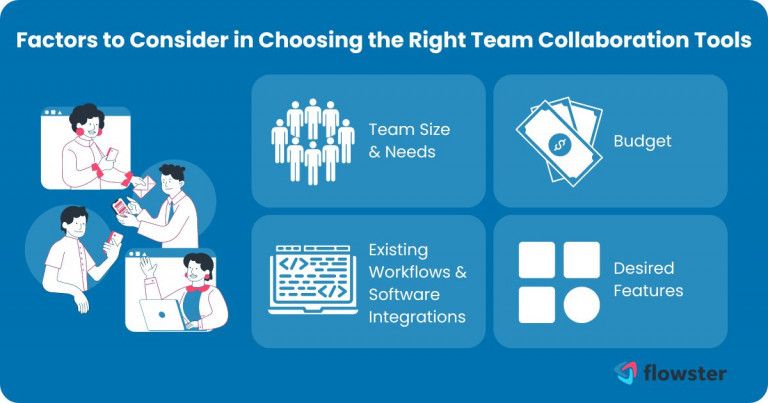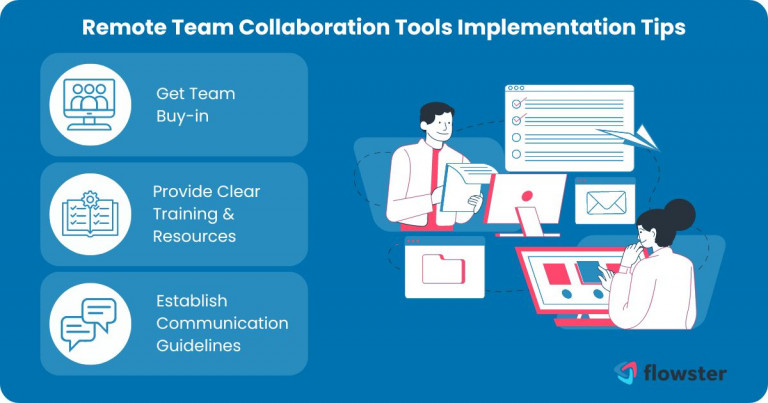The rise of remote work has brought undeniable benefits – flexibility, wider talent pools, and improved work-life balance. But managing remote teams can also present its own set of challenges. Communication can become disjointed, project updates can get lost in email threads, and maintaining team spirit across geographical distances can be tricky.
This is where the right remote team collaboration tools come in. Email, while a staple of communication, can quickly become overloaded with information in a remote setting. Instead, by adopting a suite of well-chosen tools, you can foster seamless collaboration, improve project visibility, and keep your remote team connected and engaged.
In this post, we’ll explore some of the top remote team collaboration tools available and how they can empower your remote workforce.
Article Outline
Top Remote Team Collaboration Tools
Keeping everyone on the same page and projects moving forward is crucial for any successful team, but especially for remote teams. The right remote team collaboration tools can act as a central nervous system, ensuring clear communication, streamlined workflows, and efficient project management.
Let’s explore some of the top categories of tools that can empower your remote team:
A. Project Management Tools:
Project management tools provide a visual and organized way to track tasks, deadlines, and project progress. This helps ensure everyone is aware of their responsibilities, dependencies between tasks are clear, and roadblocks are identified and addressed quickly.
- Trello: Trello offers a simple and intuitive board-based system for managing projects. Teams can create visual boards with lists representing different stages of a project (e.g., To Do, In Progress, Done) and use cards to represent individual tasks.
- Asana: For more complex projects, Asana provides powerful features for task delegation, assigning due dates, tracking dependencies, and creating subtasks.
- Flowster: If streamlining workflows and automating approval processes are your top priorities, Flowster is a great option. It allows you to design visual workflows, automate repetitive tasks, and gain real-time visibility into project progress.
Flowster's AI-Driven Automation
B. Communication & Collaboration Tools:
Clear and consistent communication is essential for building trust and fostering collaboration within a remote team. Remote team collaboration tools can help bridge the physical distance and keep everyone connected.
- Slack: Slack is a popular platform for real-time messaging, file sharing, and integrations with various third-party tools. It allows for team discussions, private messages, and even video calls, offering a versatile communication hub.
- Microsoft Teams: If your team already uses Microsoft 365, Microsoft Teams offers a comprehensive communication solution with built-in chat, video conferencing, file sharing, and integrations with other Microsoft applications.
C. Cloud Storage & File Sharing Tools:
Centralized and secure storage of files is crucial for a remote team to ensure everyone has access to the latest versions of documents and can collaborate effectively.
- Google Drive: Google Drive offers a secure cloud storage solution with real-time collaboration features. Team members can work simultaneously on documents, spreadsheets, and presentations, eliminating the need for multiple versions and version control headaches.
Now that we’ve explored some of the top remote team collaboration tools, let’s look at some key factors to consider when choosing the right ones for your specific needs.

Choosing the Right Remote Team Collaboration Tools
The vast array of available remote team collaboration tools can be overwhelming. But fear not! By considering your specific needs and following these steps, you can make informed decisions and choose the perfect tools to empower your remote workforce.
Factors to Consider:
- Team size and needs: Smaller teams might thrive with a simpler communication tool like Slack, while larger teams with complex projects may benefit from a robust project management platform like Asana. Consider the specific needs and workflows of your team when making your choices.
- Budget: Remote team collaboration tools come with a variety of pricing structures. Free and freemium options are available for many tools, but often with limitations. Carefully evaluate your needs against the features offered by different paid plans to find the best value for your budget.
- Existing workflows and software integrations: Do your team members already use specific software or have established workflows? Look for remote team collaboration tools that integrate seamlessly with your existing systems to avoid unnecessary disruption and data silos.
- Desired features: Make a list of the features most important to your team. Do you prioritize real-time communication, project management functionalities, or secure file sharing? Knowing your priorities will help you narrow down the options and choose tools that offer the functionalities you truly need.
Tips for Successful Implementation:
Once you’ve chosen your remote team collaboration tools, a smooth implementation is key. Here are some tips:
- Get team buy-in: Involve your team in the decision-making process and address any concerns they might have.
- Provide clear training and resources: Ensure everyone understands how to use the new tools effectively. Offer training sessions and create readily accessible resources.
- Establish communication guidelines: Set clear expectations for how your team will use the chosen tools for communication, file sharing, and project management.
By following these steps, you can ensure that your chosen remote team collaboration tools become valuable assets, fostering seamless collaboration and driving success for your remote team.

Conclusion: Building a Strong Foundation for Remote Team Success
The right remote team collaboration tools can be the difference between a scattered and frustrated remote team and a highly engaged and productive one. By using a combination of project management, communication, and file sharing tools, you can streamline workflows, improve transparency, and empower your remote team to achieve great things.
Remember, the best tools for your team will depend on your specific needs and budget. In addition to the tools mentioned in this post, there are many other excellent options available. Explore online review sites and software comparison resources to find the perfect fit.
So, take the first step towards a more collaborative and successful remote work environment. Explore the variety of remote team collaboration tools, carefully consider your team’s needs, and start building a strong foundation for remote success!
Streamline Workflows & SOPs for Your Remote Team
While Flowster excels at streamlining workflows in general, it offers particular benefits for remote teams. The Flowster Marketplace provides a library of pre-built, remote-ready workflow templates designed to facilitate tasks commonly encountered in remote work environments. These templates can be easily customized to fit the specific needs of your team.
Need something more tailored? Flowster’s “Done-For-You” services can help! Their expert team can create custom workflows specifically designed for your remote team’s processes and goals. This ensures your Standard Operating Procedures (SOPs) are perfectly optimized for seamless collaboration, even when your team is geographically dispersed.




